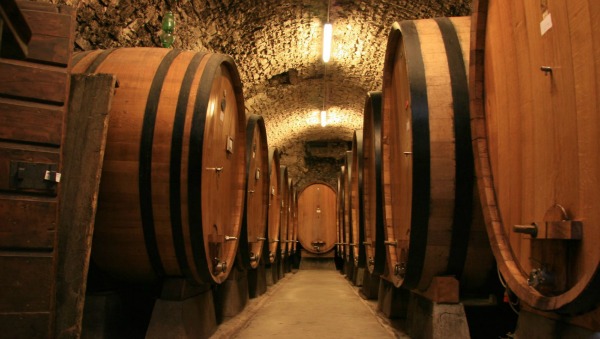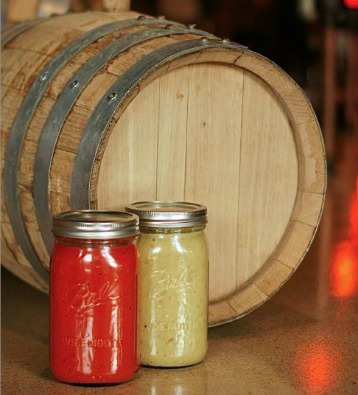The Hot Condiment of 2013? Barrel-Aged Hot Sauce
Restauranteurs across the nation are feeding a new trend by feeding hot sauce into whiskey oak barrels
![]()

Hot sauce, much like whiskey, draws in oak and smoke flavor from charred barrels as it ages. Credit: Flickr user roblisameehan.
Several food critics recently predicted barrel-aged hot sauce would be this year’s breakout condiment. The process originated nearly 145 years ago, when pepper seeds from Mexico and Central America took root in Avery Island, a salt dome in Louisiana. There, Edmund McIlhenny watched the red peppers grow, starting out green in infancy, then turning yellow, orange and finally deep red and ready for picking. He mashed them and mixed in salt from the island’s underground mines. Then, he dumped the mixture into white oak barrels, where it aged for three years, slowly fermenting.
Tabasco red pepper sauce was born.
When whiskey is freshly distilled, it is colorless and only tastes and smells like the grain and the alcohol. It gets its color and richness in flavor from aging in charred oak barrels. Hot sauce, like Tabasco, works much the same way—it soaks in flavor and grows deeper in color in the barrel.
In 2009, a former chef at Vesta Dipping Grill in Denver purchased an eight-gallon charred whiskey oak barrel to add some smoky flavor to the restaurant’s house-made sauces. Last year, Vesta’s executive chef, Brandon Foster, purchased two more barrels, and they sit in the restaurant’s basement, allowing the chiles to age and absorb wood tannins and hints of whiskey.
The first iteration, dubbed Hudson Barrel Hot Sauce, became a Louisiana-style sauce made with red Fresno chilies and habaneros, onion, garlic, salt and vinegar. After the chilies are pickled for two weeks in cans, the barrel is rinsed with a bottle of whiskey, and the mixture ages for a minimum of four weeks. Around week six or eight, the whiskey flavor really seeps in, says Foster, and the resulting flavor is smoky with an acidic punch and some background heat.
Vinegar and salt pull moisture from the barrels into the hot sauce, bringing flavor with them, Foster says.
“The barrel has sauce aged in it, it’s had whiskey aged in it,” Foster says. “It’s going to have excess moisture in it and I think that’s the salt and the vinegar, the macerated chilies, that are really just reacting with that wood and pulling out as much flavor as possible.”

Hudson Barrel Hot Sauce matures for four to eight weeks in oak whiskey barrels before it’s bottled and served. Photo by Taryn Kapronica.
The first barrel, which cost $130, produced eight batches of hot sauce before Foster noticed signs of wear and tear and feared leaking or mold. His two new barrels have gone through ten to 12 batches of hot sauce, and recently welcomed a new concoction—this time, using tequila.
The new recipe, created by one of Vesta’s kitchen managers, calls for Serrano peppers, roasted jalapenos, habaneros, onions, garlic and red wine vinegar mashed together and poured into a tequila-rinsed barrel. The green, Latin America-style sauce, which will be hotter and sweeter than Hudson Barrel Hot Sauce, will debut at the restaurant in a few weeks.
What sort of volume goes through one eight-gallon barrel during its lifetime? A lot: 250 to 300 pounds of chilies, 60 to 70 pounds of onions, 20 to 25 pounds of garlic and generous helpings of salt and vinegar. Foster uses chiles from California for the current batch, as Colorado’s winter weather isn’t easy on pepper crops.
Once the sauces have matured, the mixture is pureed, but it’s not smooth by any means, Foster says. He drains the barrel by setting it on a counter above a bucket and shaking it back and forth, then tosses the mash into a high-powered Vitamix blender, after which it’s pureed further through a cap strainer. Some pulp remains to add viscosity to the sauce, which is seasoned, bottled and served at Vesta’s sister restaurant Steuben’s, alongside 20 to 30 other hot sauces. And since the barrels are replenished regularly, some of the flavor customers taste has been building for two years.
For Ronnie New, executive chef at Magnolia Pub and Brewery in San Francisco, barrel aging hot sauce is a new venture. He’s been making his own hot sauce, similar to Sriracha, for a year and a half, adding it to the restaurant’s wings and fried chicken. Magnolia has no shortage of barrels—its bar buys bourbon and whiskey by the barrel for its house cocktails—so tossing hot sauce into one of them seemed like a logical move.
By June, he’ll fill a 53-gallon Evan Williams bourbon whiskey white oak barrel with 200 pounds of locally sourced chilies, age the mash for six months, and bottle it by 2014. As the vinegar in the mash starts to denature the chilies, New says some natural sugar will be released, causing the mixture to ferment. When natural proteins are exposed to salt and changes in pH, their coils unwind, and they tend to bond together to create solid clumps, losing some of their capacity to hold water.
“Hot sauces tend to develop more and more flavor the longer they sit,” says New, who will monitor the flavor as the mash ages. “Every single environment is different, so there’s not an exact formula. The end product might be slightly different each time we do it.”
On the opposite coast, Sam Barbieri, owner of Waterfront Alehouse in Brooklyn, recently emptied a 31-gallon barrel whiskey full of hot sauce and added it to his restaurant’s wings and buffalo-style calamari.
“If you’re aging whiskey in a barrel and dump it out, there’s still about eight to ten percent retention in the wood from the whiskey,” Barbieri says. “I put the sauce in there, and all those beautiful vanilla and oak tones will come into my hot sauce.”
The sauce, made from chocolate habaneros, Bishop’s Crown peppers and Serranos, ages for two years. The end result is extremely hot, so Barbieri adds pureed carrot or apple cider vinegar to balance the flavor and arrive at his desired pH level, roughly 3.5, a number he says those in the canning industry aim for to create a stable product. Then, he heats the sauce at 192 degrees Fahrenheit for five minutes before bottling it.
Unlike Foster, Barbieri doesn’t reuse his barrels. Instead, he throws its staves into his barbecue pit to infuse pepper flavor into roasted hogs, adding hickory and apple. He’s in talks with local distilleries about acquiring his next barrel.
“As soon as you age your whiskey, I will come pick up your barrel,” he says.
/https://tf-cmsv2-smithsonianmag-media.s3.amazonaws.com/accounts/headshot/marina-koren-240.jpg)
/https://tf-cmsv2-smithsonianmag-media.s3.amazonaws.com/accounts/headshot/marina-koren-240.jpg)